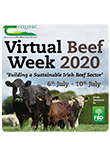
Grazed grass is the cheapest source of energy for ruminants and is capable of supporting high levels of animal performance. Beef systems implementing high levels of grassland management to support improved animal performance and output/ha have a lower carbon footprint per kg of beef produced. Nicky Byrne, Donall Fahy and Michael O’Donovan have some advice
- Date
- 7 July 2020
- Type
- Media Article

The current research focus of the dairy beef unit at Teagasc Grange is to compare the performance of three DAIRY-BEEF genetic groups. The systems used have achieved exceptional performance.Nicky Byrne and Donall Fahy give an update on the research
- Date
- 7 July 2020
- Type
- Media Article

The second phase of Teagasc Green Acres Calf-to-Beef Programme started in 2019. It includes 12 commercially-operated calf to beef demonstration farms located nationwide. This programme is supported by two Teagasc specialised advisors. Programme manager Alan Dillon has more information
- Date
- 7 July 2020
- Type
- Media Article

Livestock production systems consistently rank as one of the most hazardous with regard to farmer safety. Between 2009 and 2018, 16% of total fatalities in the Irish agricultural and forestry industry occurred in these production systems. A study of beef farmers on livestock handling has been conducted by Teagasc & UCD
- Date
- 6 July 2020
- Type
- Media Article

At Teagasc, Grange, new technologies are being used for the identification of viral and bacterial infectious agents causing bovine respiratory disease (BRD), commonly known as pneumonia. Researchers Dayle Johnston, Matthew McCabe, Gaelle Esnault, Inmaculada Cuevas-Gómez, Paul Cormican, Sinead Waters and Bernadette Earley give some information
- Date
- 6 July 2020
- Type
- Media Article

Bovine respiratory disease (BRD) is is one of the most significant causes of morbidity and mortality in cattle. An accurate and early diagnosis of clinical (BRD) and sub-clinical bovine respiratory disease (sBRD) is necessary to get a better classification of the disease and guide effective treatment.
- Date
- 6 July 2020
- Type
- Media Article

Bovine respiratory disease (BRD) is a multifactorial disease affecting cattle of all ages. Internationally and in Ireland, it represents the most significant cause of bovine morbidity and mortality. Clinical symptoms include coughing, breathing difficulty, eye and nasal discharge, a high temperature and reduced animal performance.
- Date
- 6 July 2020
- Type
- Media Article
The castration of male cattle intended for beef production is a common practice in many countries. Castration is considered to cause a degree of pain and stress and has been shown to elicit physiological stress, inflammatory reactions, pain-associated behaviour, suppression of immune function and a reduction in performance. The nature and duration of an animal’s response to castration are dependent on a number of factors, including the method employed, the age of animals, the post-castration management, and whether or not pain relief is provided.
- Date
- 6 July 2020
- Type
- Factsheet

The Derrypatrick Herd is a suckler beef research herd based at Teagasc Grange. The herd is predominantly Limousin and Simmental crossbreds, with replacement heifers purchased as weanlings the autumn prior to breeding. All heifers and cows are bred to AI with heifers bred to Angus sires and cows bred to a combination of Charolais, Limousin and Simmental sires.
- Date
- 6 July 2020
- Type
- Media Article

Find out the reasons for calving your beef heifers at 2 years old; why farmers are reluctant to try it and get some key statistics to help make the decision.
- Date
- 6 July 2020
- Type
- Media Article
